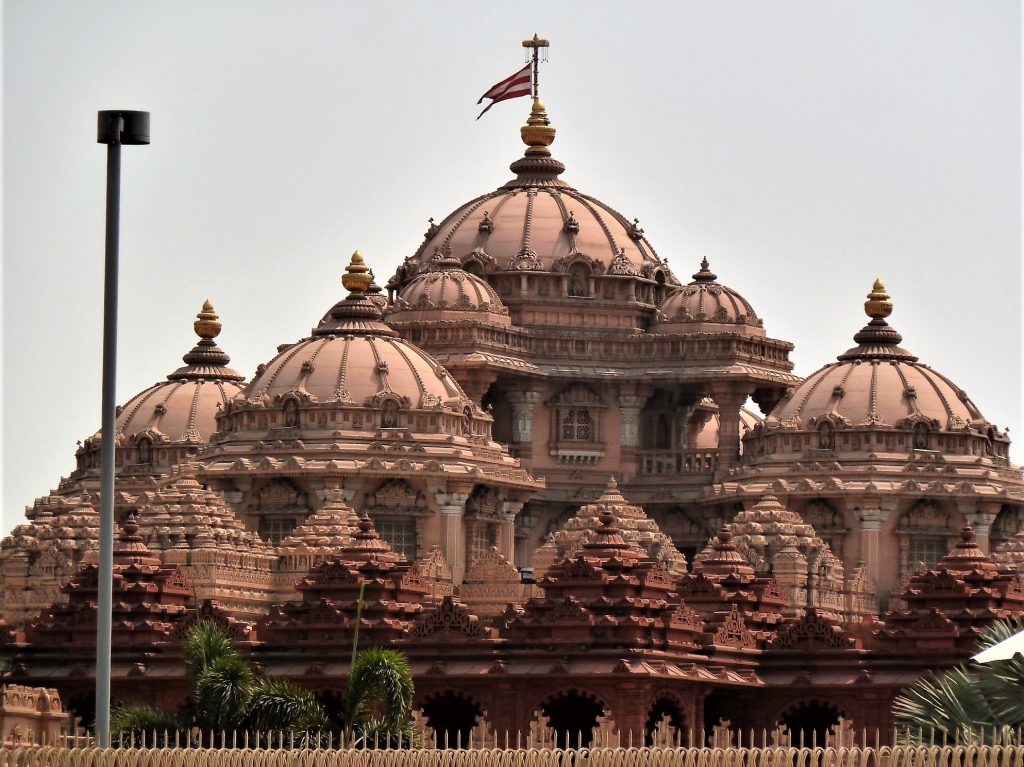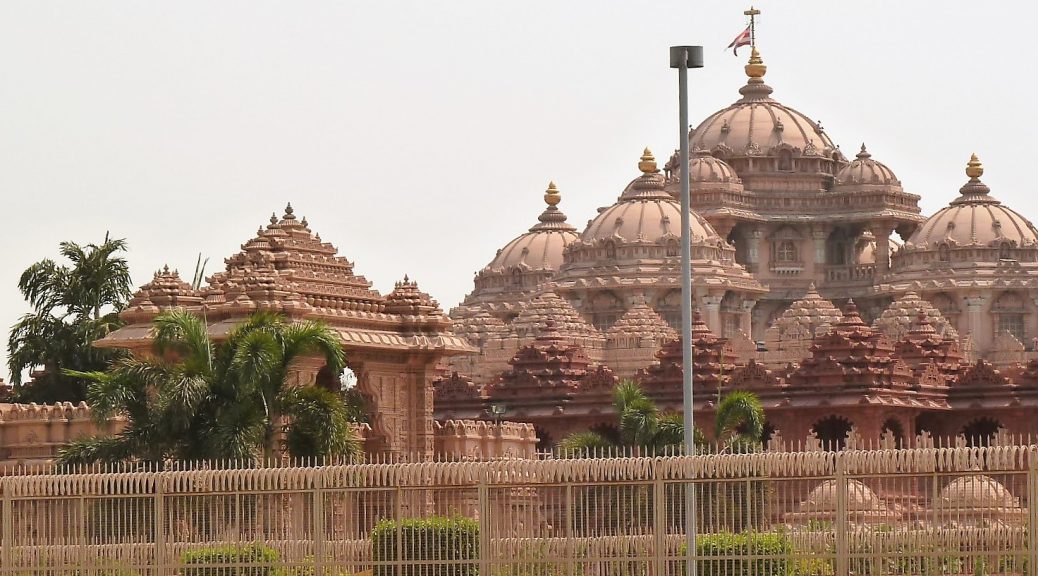The Akshardham Temple or Swaminarayan Akshardham Complex is a Hindu temple located in Noida Mor in New Delhi, which exhibits various beautiful monuments which makes it so special and fascinating. The name Akshardham is derived from two words – akshar meaning eternal and dham meaning adobe. So, Akshardham means the abode of the eternal one. The Guinness Book of World Records states that the temple holds the world record of being the “world’s largest comprehensive Hindu Temple ” with 356 ft height and 141 ft width, covering a total area of 86,342 square ft. It was Michael Witty, a representative from the Guinness World Records who announced it before an audience of around three thousand people on the occasion of the BAPS Swaminarayan centenary celebrations in Ahmedabad, Gujarat in December 2007 (Kim 359). The Akshardham Temple was not only the most ambitious project taken on by the prominent Hindu sect, but it was the most significant one as well. Devotees from different countries of Europe, North America, East Africa and India donated funds, time and skills to set up a $45 million temple-cum-exhibition complex in India’s capital (Singh 34).
Akshardham temple was completed by the BAPS in November 2005 (Srivastava 339). It was inaugurated by, APJ Abdul Kalam who was the president of India at that time, and he described it as “the civilization heritage of India in dynamic form” (Singh 52). From the day it opened, the temple was inserted into the catalogue of India’s great monuments(Singh 52). The complex is said to be visited by 70% of the tourists and it has become one of major tourist attractions of New Delhi (Paine 402).
The Bochasanwasi Akshar Purushottam Sanstha (BAPS) is one of the most visible manifestations of transnational Hinduism today and is said to be the fastest growing Hindu sect in the world (Singh 48). The BAPS community originated in 1907 by Shastri Maharaj (Kim 362). In the past years, the BAPS has become the most prominent sub-sect of the Swaminarayan Sampradaya, with more than seven hundred centres in Australia, Asia, Africa, Europe, and North America (Singh 48). The major credit behind the rapidly increasing growth is given to its current head, Pramukh Swami Maharaj and he was born in 1921 (Kim 363). According to its estimates, BAPS has approximately one million followers, with the majority residing in India, 30,000 followers in UK and 40,000 in the US (Kim 362).
According to the BAPS Swaminarayan Sanstha, the construction of the temple took more than 300,000,000 hours and over 8,000 volunteers from across the world participated in building it. Through the construction of the Akshardham temples, BAPS has strategically used the built realm to promote its religious ideology and advance its political agenda (Vijayakumar 37). Under the rule of Pramukh Swami Maharaj, most of the time was devoted to a typical form of monumental architecture (Singh 49). The works of BAPS have been so great that it has established its own in-house temple design studio in Ahmedabad as well as a stone-carving work-shop at Pindwara in Rajasthan with more than seven thousand carvers and more than eight hundred craftsmen at work (Singh 50).
The Akshardham temple in New Delhi, represents Pramukh Swami Maharaj’s unparalleled devotion to Bhagwan Swaminarayan and fulfils Brahmaswarup Yogiji Maharaj’s long-cherished wish for such a tribute to Bhagwan Swaminarayan in the nation’s capital ( Bliss 2010:6).The idea to build such complex may be traced back to its celebrations of Swaminarayan’s birth bicentenary in 1981 (Singh 51). During that phase, temporary structures were built by using bamboo, plaster, and burlap on two hundred acres of land in Ahmedabad to showcase the life of Swaminarayan, the family values and vegetarianism (Singh 51). Around eight million people were reported to have visited that festival. After the success of the festivals a permanent site was finalised and in 1992, the first Akshardham complex was opened in Gandhinagar, Gujarat (Singh 51). Initially when the temple was being planned in about 1990, a prominent temple architect, Amritlal Trivedi was approached to take on the project. Some of the BAPS temples such as in Chicago and Houston were also built by his family. The senior architect, Amritlal Trivedi worked with his son Krishnachandra and grandson Virendra, who brought this project to completion. Even before the site was identified and the land was acquired, the process of designing of Akshardham had already begun (Singh 60).

Thirteen years after the first Akshardham was inaugurated at Gandhinagar, Yogiji Maharaj announced to open a second temple in Delhi on the banks of the Yamuna River (Singh 52). It was not less than a miracle to find a site so large and central, in the crowded megacity of Delhi and that too on the bank of the Yamuna River. In the year 2000 the government of India allotted a piece of land on the floodplains of the Yamuna river to a socio-religious organization(Vijayakumar 37). The construction of temple also faced several public controversies over the manner in which such a large parcel of ecologically sensitive area had been allotted for the construction (Srivastava 339). Also, in the year 2003 and 2004 several newspaper reports suggested that the NDA (National Democratic Alliance) helped BAPS to get the land even after violation and planning patterns (Srivastava 339). Finally, in 2005, the Supreme Court came to a decision that the construction had been “lawful”, and that “all the land use Plans have been adhered to” (Srivastava 339).
The main access to the temple from Delhi is by metro as it is the fastest means of transportation to the site. However, the most direct approach to the temple is by the Hazrat Nizammuddin bridge that spans the Yamuna (Srivastava 339). Near to the complex is the site for the 2010 Commonwealth games “village”. The Nangla Machi remains can be seen from the sites of both the game and the temple complex. The Nangla Machi, which was the area of slums, was recently destroyed by the government to make the surrounding area look clean and beautiful (Srivastava 339).
Visitors travel either by public transport or by private vehicles. The cars and buses have a huge parking lot which is not unlike the ones near shopping centres. The entrance at the temple has numerous security checks (Srivastava 339). The visitors are not allowed to carry any edibles or gadgets along with them. Also, they have to submit the electronic gadgets and bags at the front entrance which is near the parking lots. The temple is usually busy during festivals and holidays. The temple is closed on every Monday and the ticket window remains opened from 10am to 6pm. Before entering inside the complex, the visitors have to undergo three checks, including body frisking, and inspection with the metal detectors (Srivastava 339). After going through the security checks, appears the Mayur Gate, which is decorated with 869 peacocks (Srivastava 339). The massive dome of the temple is visible from some distance. At the entrance the display of the eight water screens can also be seen. After entering inside, the visitors move into a large hall made from marble with low lighting and decorated with greenery. Passing from the main gate, the hall gets divided into different sections, and some of these require an entry fee, in particular, a combined ticket for the Halls of Values (Srivastava 339). Sahajanand Darshan (also Hall of Values) is an “audio animatrix show”, Neelkanth Darshan, which is a theatre show, and Sanskruti Vihar (a boat ride) costs around Rs 125. The Musical Fountain and Garden of Values and the temple collectively are the major attractions.
The Akshardham monument is made from pink sandstone and the interior is made up of white marble that visibly resembles ancient sites, and is constructed using ancient methods (Singh 56- 57). It is a complete and brilliant mixture of tradition and technology. The building has been acclaimed as one of the most intricate structures to be made in India since Independence, and the complex’s guidebook tells us that its ‘234 ornately carved pillars, 9 ornate domes and 20,000 murtis and statues’ were assembled from a total of three hundred thousand pieces of carved stone (Singh 56). Every monument in the temple has its own beauty and specialty. The Hall of Values features lifelike robotics and dioramas that display incidents from the life of Swaminarayan, portraying his message on importance of peace, harmony, humility, service to others and devotion to god (Srivastava 340). Art robotics, fibre optics, light effects, dialogues and music are used to make the audience feel ancient Hindu culture and messages like non-violence, morality and more through 15 3-D dioramas with the use of state of art robotics (Srivastava 340).
The Neelkanth Darshan Theatre is Delhi’s one and only large format screen with 85 ft height and 65 ft width. A 40-minute film, Neelkanth Yatra is shown to relate a seven-year pilgrimage made by Swaminarayan during his teenage years in India. There is also a 27 ft tall bronze murti of Neelkanth Varni just outside the theatre. The Sanskruti Vihar or the boat ride is a 12-minute journey showing the life in Vedic India all through 10,000 years of glorious heritage using robotics (Srivastava 339). It also shows the major contributions of Vedic Indians like Aryabhatta in mathematics and many more in their respective fields like science, astronomy, arts, literature and yoga. The musical fountain, also known as the Yagnapurush Kund is one of the most beautiful monuments in the temple. A breath-taking presentation of 24 minutes is shown in the water show named Sahaj Anand at the fountain at night. The presentation is displayed using modern technology like multi-colour lasers, video projections, underwater flames and brilliant sound system. The additional features of the temple are the Yodi Hraday Kamal, a lotus shaped sunken garden, the Nilkanth Abhishek (ritual of pouring water on the murti), the Narayan Sarovar and the Premvati Ahargruh (food court).
REFERENCES AND FURTHER RECOMMENDED READING
Vijayakumar, Swetha (2014) “Making of a “Hindu National Temple”: Tradition and Technology at Swaminarayan Akshardham.” Traditional Dwelling and Settlements Review, Vol 26, No. 1: 37-40.
Nair, Ravi (2014) “Akshardham Judgement-I: The Law at Work.” Economic and Political Weekly, Vol 49, No. 25: 15-17.
Singh, Kavita (2010) “Temple of Eternal Return: The Swaminarayan Akshardham Complex in Delhi”: Artibus Asiae, Vol 70, No. 1: 1-31.
Kim, Hanna (2009) “Public Engagement and Personal Desires: BAPS Swaminarayan Temples and their contribution to Discourses on Religion.” International Journal of Hindu Studies, Vol. 13, No. 3: 200-370.
Paine, Crispin (2016) “Material Religion: The Journal of Objects, Art and Belief,” 12:3, 402-403.
Srivastava, Sanjay (2009)” Urban Spaces, Disney-Divinity and Moral Middle Classes in Delhi.” Economic and Political Weekly, Vol. 44, No. 26/27.
Related Topics for Further Investigation
BAPS
Akshardham Complex Gujrat
Pramusk Swami Maharaj
Yogiji Maharaj
Swaminarayan Sampradaya
Yamuna River
Noteworthy Websites Related to the Topic
https://akshardham.com/visitor-info/
https://www.hinduismtoday.com/
https://en.wikipedia.org/wiki/Akshardham_(Delhi)#Exhibits
https://en.wikipedia.org/wiki/Bochasanwasi_Akshar_Purushottam_Swaminarayan_Sanstha
Article written by: Dilnaaz Kaur Chahal (Spring 2020), who is solely responsible for its content
